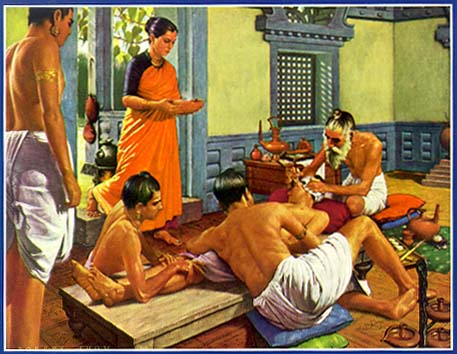

We reproduce here extremely important excerpts from ancient Indian medical scriptures Charak Samhita (Ch.) and Sushruta Nidanastahan [Su.Ni.]. All the slokas are enclosed in boxes.The compilation, translation and interpretation has been made by Dr. Heema Seth an Ayurveda consultant of Mumbai. (You can follow the links below or simply scroll down)
4. Mansa-Arbud
5. Prognosis
7. Treatment
| "Gatra
pradeshe kwachidev doshaaha
sammurchhita mansamasruk pradushya.
Vruttam
sthiram mandrujam mahantamanalpmulam
chirvruddhyapakam. Kurvanti
mansocchrayamatyagaadham Tadarbudam shastravido vadanti.[ Su.Ni. 11] |
Due to vitiation of the
flesh and blood by deranged and aggravated Doshas (vayu, pitta and kapha) a large
vegetation of flesh appears at any part of the body which becomes rounded,
immovable, slightly painful and has its root considerably deep in the flesh
(affected part ).This growth is termed as ARBUD by the learned physicians.![]()
|
Rogaschotsedh samanyaadhimansarbudadayaha [Ch.] |
Arbud (tumor) is a disease in which swelling (utsedh) is a common feature.
Aram-sheeghram
- (which is fast) bundati-gyapayati- (appearing) mansocchrayam-(originating in
flesh)-swarupam-gatrapradeshe-(in body)-sammurchhitai-doshairrmansasruk-pradushanad-
(formed due to deranged blood n flesh) yat-tad-arbudam (is termed as arbudam)
Urbundara
nishamne,mulvibhujadeeh,prushodaradisch yadva arbati-gachhati
gatrapradeshe-kutrapi-yad arb gatau(one which has a pervading ,
omnipresent/potent deep seated root in the body) - Udach;
yadva-arbudgirisadrusham (raised like a mountain) vruttakaram
sthiram mahad analpmulam (rounded, immobile, large, deep spreaded root) cha
yattjayate-tatsadrushyad idamapi.![]()
|
Vaaten pitten kaphen vaapi rakten mansen cha medsa va. [Su.Ni.11] |
In ayurvedic texts,arbud is described of six types on the basis of origin of derangement of doshas and vitiation of blood, flesh and fat.
Of the above
mentioned,mansaj and raktaj are considered to be Ghatak(malignant). They are
incurable(asadhya)And rest of them are considered as Saumya(benign) [ref:Ch.]
These are slow growing(cheer vruddhi)and do not metastasize(aprasaranshil),
encapsulated (Vipatya chodhrrotya bhishak sakosham shastren daghdhwa vranvat -
excision along with the capsule and cauterize like a wound) [Ch.Chi.12] ![]()
|
Doshaha
pradusto rudhiram shirastu sampidya
sankochya gatastu pakam.
Sasraavamannuhyati manspindam
mansankurrairachittamaashuvruddhim. Sravatyajasram
rudhiram pradustamasadhyametadrudhiratmak
syat Raktakshayopdravpeedittvaat pandurbhavetpeeditastu. [Su.Ni.] |
The
deranged doshas (vaayu, pittam, kapha) contracting and compressing the vessels (sira)
and blood (rudhir) of affected part, raise a slightly suppurated (paakam)
exuding tumor covered with small warts and fleshy tubercles and is called as
Raktarbuda. This tumor is rapid in its growth, exuding a constant flow of
vitiated blood. It is considered incurable (asadhya) due to its origin in blood.
The patient looks pale and yellow because of disturbance and depletive actions
due to hemorrhage. ![]()
|
Mushtipraharadibhirardite
ange manspradustam
prakaroti shofam. Avedanam snigdhamananyavarnam
apakamashmopmamaprachalyam. Pradustmansasya
narasya baaddhmetanbhavenmans
parayansya. Mansarbudam tvetadasadhyamuktam. |
When
flesh of any part of body gets vitiated due to external irritation like
blows,etc, it gives rise to swelling(shofam) called as Mansarbuda. It is
painless, glossy, of same color as the surrounding, non suppurating, stony hard
and immobile. If such a tumor appears in a person addicted to meat diet (mansparayan),
the tumor (mansarbud) gets deep seated due to consequent vitiation of bodily
flesh (mans). As per Susruta this is incurable tumor. ![]()
|
Mansarbudam tu
etad asadhyamuktam sadhyeshvapeemani
vivarjayet tu.
Samprasrutam marmani yaccha jaatam srotasahsu va yaccha bhavedachalyam. [Su.Ni.11] |
From the earlier stated curable types (vaataja, pittja,etc.),those which appear in any vital/vulnerable joint of the body or in any cavity(Srotas), channels or artery, characterized by any sort of exudation and are immobile, should be deemed incurable.
These are better left untreated.
|
Sheshe krute
paakvashen shiryat tatah kshatotha prasaredvisarpah. Updravam tampravicharya Tajagyastairyabhaishajaih purvatarai yathoktaihee [Ch.Chi. 12] |
According to Charaka , if it is excised carelessly leaving even a small root in the body, then it starts proliferating and suppurating due to injury (kshat) and spreads on its own through blood vessels like visarp.
This
can be compared to hemal dispersal of cancer cells.
![]()
|
Yajjayte anyat khalu purvajaate gneyam
tadadhyarbudagyeeh.
Yat dwandwajaatam yugpat kramadwa dwirarbudam taccha bhaveasadhyam. |
An arbudam which crops up on the existing one is called as Adhyarbudam. A couple of contiguous arbuda (tumors) cropping up simultaneously or one after another is called Dwirarbudam. Both these types are considered incurable.
These can be compared to secondary tumors and metastasis.
|
Na pakamayati
kapahadhikatvanmedo adhiktvat
cha visheshastu. Doshsthirtvad grathanachha tesham sarvarbudanyev nisargastu.[Su.Ni.11] |
An
arbuda never suppurates owing to the exuberance of the deranged Kapha and
fat as well as in consequence of the immobility, condensation and compactness of
the deranged doshas(Vaayu, pitta, kapha) involved in it or out of a specific
trait of its own nature.![]()
Treatment for sadhya (saumyarbudas):
Blood letting in vaataj arbud,
Cauterization by alkalis (dahan karma) in paittik arbud.
Kaphaja and Medoj arbud ) are to be treated surgically.If little tissue remains after surgery , it proliferates again.(Sasheshdoshani hi yo arbudani karoti tanyashu punarbhavati). This can be compared to neo canceration of normal cells after surgery.